Related Research Articles

A doughnut or donut is a type of food made from leavened fried dough. It is popular in many countries and is prepared in various forms as a sweet snack that can be homemade or purchased in bakeries, supermarkets, food stalls, and franchised specialty vendors. Doughnut is the traditional spelling, while donut is the simplified version; the terms are used interchangeably.

Beignet is a type of fritter, or deep-fried pastry, possibly made from pâte à choux and called pets-de-nonne, which means "nun's fart" in French, but may also be made from other types of dough, including yeast dough. In France there are at least 20 different versions. They can vary in shape, the flour used for the dough, and the filling. They are popular in French, Italian, and French-American cuisines.

A churro is a type of fried dough from Spanish and Portuguese cuisine, made with choux pastry dough piped into hot oil with a piping bag and large closed star tip or similar shape. They are also found in Latin American cuisine, Philippine cuisine, and in other areas that have received immigration from Spanish and Portuguese-speaking countries, especially in the Southwestern United States and France.
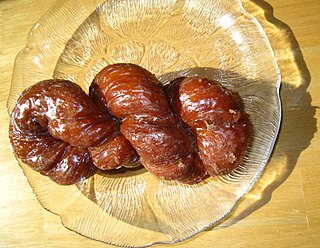
A cruller is a deep-fried pastry like a doughnut popular in Europe and North America often made from a rectangle of dough with a cut made in the middle that allows it to be pulled over and through itself, producing twists in the sides of the pastry. The cruller has been described as resembling "a small, braided torpedo". Some other cruller styles are made of a denser dough somewhat like that of a cake doughnut formed in a small loaf or stick shape, but not always twisted. Crullers may be topped with powdered sugar or icing.

Fried dough is a North American food associated with outdoor food stands in carnivals, amusement parks, fairs, rodeos, and seaside resorts. "Fried dough" is the specific name for a particular variety of fried bread made of a yeast dough; see the accompanying images for an example of use on carnival-booth signs. Fried dough is also known as fry dough, fry bread (bannock), fried bread, doughboys, elephant ears, beaver tails, scones, pizza fritte, frying saucers, and buñuelos. These foods are virtually identical to each other and some yeast dough versions of beignets, and recognizably different from other fried dough foods such as doughnuts or fritters.

Ukrainian cuisine is the collection of the various cooking traditions of the people of Ukraine, one of the largest and most populous European countries. It is heavily influenced by the rich dark soil (chernozem) from which its ingredients come, and often involves many components. Traditional Ukrainian dishes often experience a complex heating process – "at first they are fried or boiled, and then stewed or baked. This is the most distinctive feature of Ukrainian cuisine".
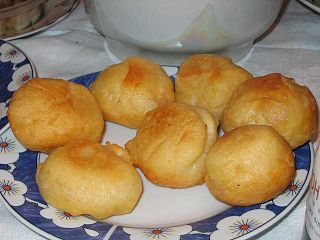
Pampúshka is a small savory or sweet yeast-raised bun or doughnut typical for Ukrainian cuisine.

A fritter is a portion of meat, seafood, fruit, vegetables, or other ingredients which have been battered or breaded, or just a portion of dough without further ingredients, that is deep-fried. Fritters are prepared in both sweet and savory varieties.
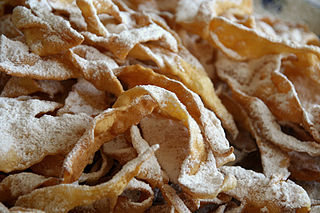
Angel wings are a traditional sweet crisp pastry made out of dough that has been shaped into thin twisted ribbons, deep-fried and sprinkled with powdered sugar. Common to many European cuisines, angel wings have been incorporated into other regional cuisines by immigrant populations. They are most commonly eaten in the period just before Lent, often during Carnival and on Fat Thursday, the last Thursday before Lent – not to be confused with "Fat Tuesday", the day before the start of Lent. There is a tradition in some countries for husbands to give angel wings to their wives on Friday the 13th in order to avoid bad luck.

Christmas cookies or Christmas biscuits are traditionally sugar cookies or biscuits cut into various shapes related to Christmas.

Czech cuisine has both influenced and been influenced by the cuisines of surrounding countries and nations. Many of the cakes and pastries that are popular in Central Europe originated within the Czech lands. Contemporary Czech cuisine is more meat-based than in previous periods; the current abundance of farmable meat has enriched its presence in regional cuisine. Traditionally, meat has been reserved for once-weekly consumption, typically on weekends.

A buñuelo is a fried dough fritter found in Spain, Latin America, and other regions with a historical connection to Spaniards, including Southwest Europe, the Balkans, Anatolia, and other parts of Asia and North Africa. Buñuelos are traditionally prepared at Christmas. It will usually have a filling or a topping. In Mexican cuisine, it is often served with a syrup made with piloncillo.

Rosette cookies are thin, cookie-like fritters made with iron molds that are found in many cultures. Rosettes are crispy and typified by their lacy pattern. Rosettes are traditionally made during Christmas time. Rosette recipes are popular in the United States among families with Scandinavian ancestry.

Boortsog or bawïrsaq is a type of fried dough food found in the cuisines of Central Asia, Idel-Ural, Mongolia and the Middle East. It is shaped into either triangles or sometimes spheres. The dough consists of flour, yeast, milk, eggs, butter, salt, sugar, margarine. Tajik boortsog are often decorated with a criss-cross pattern by pressing the bottom of a small strainer on the dough before it is fried.
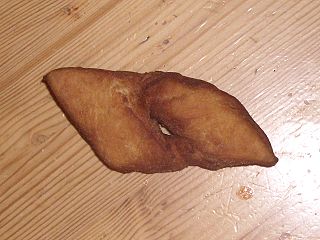
Klenät, kleinur, klena, klejne, kleina, kleyna, and fattigmann are all names for angel wings, a fried pastry common in the Nordic countries as well as the rest of Europe and the United States. In nearby countries and Eastern European countries. The name is related to klen, the Swedish term for "slender", but is originally of Low German origin, which may indicate that the pastry was originally German. It is made from flattened dough cut into small trapezoids. A slit is cut in the middle and then one or both ends pulled through the slit to form a "knot". The kleina is then deep-fried in oil or another kind of fat. Subsequently can be sprinkled with powdered sugar and cinnamon.
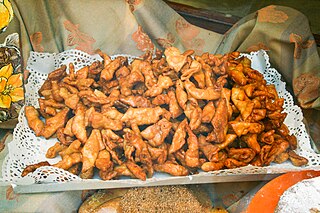
A pestiño is a Christmas or Holy Week pastry that is popular in Andalusia and other regions of southern Spain. It is a piece of dough, deep-fried in olive oil and glazed with honey or cinnamon sugar.
Nevryo is an Indian sweet dumpling made predominantly in Dakshina Kannada and Udupi districts of Karnataka and Goa, just before Christmas. It is also prepared during the Hindu festivals of Diwali and Ganesh Chaturthi.
References
- ↑ Christmas Prusarate recipe CDKitchen
